Introduction to UML
Unit 7 Introduction to UML
Structure
7.1 Introduction
7.2 What is UML?
7.3 Use Case Diagrams
7.3.1 Use Case
7.3.2 Actor
7.3.3 Associations
7.3.4 Includes
7.3.5 Generalization
7.3.6 Extends
7.3.7 Applications of Use Case Diagrams
Self Assessment Questions
7.4 Class Diagrams
7.4.1 Packages
7.4.2 Classes
7.4.3 Attributes
7.4.4 Operations
7.4.5 Generalization
7.4.6 Interfaces
7.4.7 Associations
7.4.8 Aggregation and Composition
7.4.9 Dependencies
Self Assessment Questions
7.5 Object Diagrams
7.6 Interaction Diagrams
7.6.1 Instances and Messages
7.6.2 Sequence Diagram
7.6.3 Collaboration Diagram
Self Assessment Questions
7.7 Activity and State Diagrams
7.7.1 Activity Diagram
7.7.2 State Diagram
Self Assessment Questions
7.8 Implementation Diagrams – Component and Deployment
7.9 Extensibility Mechanisms
7.9.1 Stereotypes
7.9.2 Tagged Values
7.9.3 Constraints
Self Assessment Questions
7.10 Summary
7.11 Terminal Questions
References and Further Reading
7.1 Introduction
Despite the fact that several advanced languages have come out of the Information Age Revolution, such as Java, C++, XML, etc., many people are still designing their code with minimal design in mind. They fall back on the IDE to do the work for them and this as far as the design goes. This may seem acceptable in the short term, but if it’s a long term, large project involving many individuals on the project, this is a recipe for disaster. Although, graphic design has been accepted in many of the other engineering fields: Mechanical, Electrical, Architectural, for some reason software design has been very slow to adopting these methods. The main reason is that most people feel it’s a lot of extra work. Some other reasons are that people feel the tools aren’t quite there yet, lack of understanding of the methodologies, too many competing methods, too much design concepts to learn. UML is an attempt to solve some of the common issues. It’s been marketed well by Rational and it is becoming widely accepted in corporations. It seems to bring together some of the best concepts in the Object-Oriented community and provide a common way for people to communicate design. It is also adopted by the Object Management Group and is quickly becoming a standard. UML is not specific to any one implementation and brings together models that have been used for years by programmers to describe their software. UML may not be perfect design methodology, but it has adapted well to the existing technologies and is what’s out there now.
Objectives
Understanding the contents of this chapter will help you to:
· Understand UML and its advantages.
· Understand Object-Oriented Analysis and Design using UML.
· Describe the various modeling diagrams of UML, i.e., their components, usage considerations, features, and advantages.
· Know the UML extensibility mechanisms.
· Design any kind of project using Object-Oriented Analysis and Design using UML.
7.2 What is UML?
UML is the Unified Modeling Language. The Unified Modeling Language was formed in attempt to unify the best (or most popular in this case) methods in Object-Oriented Analysis and Design. Those concepts come from the leaders in the field of OO: Grady Booch, James Rumbaugh and Ivar Jacobson. The different models are pulled from each of the individual methods and bring in a contribution from each one. For example, the class model is very similar to OMT or the Rumbaugh method. The Use Case Model is brought in from Ivar Jacobson and the implementation model is from Booch. Some models, such as State and Sequence, are a combination of a few methods, taking concepts from each of the methodologies and even adding some new concepts.
The heart of object-oriented problem solving is the construction of a model. The model abstracts the essential details of the underlying problem from its usually complicated real world. Several modeling tools are wrapped under the heading of the UML, which stands for Unified Modeling Language.
Let’s understand the necessity of UML, and how it applies to problem solving. “Why is UML important?” is the inevitable question to be answered. Let's look at this question from the point of view of the construction trade. Architects design buildings. Builders use the designs to create buildings. The more complicated the building, the more critical the communication between architect and builder. Blueprints are the standard graphical language that both architects and builders must learn as part of their trade. Writing software is not unlike constructing a building. The more complicated the underlying system, the more critical the communication among everyone involved in creating and deploying the software. In the past decade, the UML has emerged as the software blueprint language for analysts, designers, and programmers alike. It is now part of the software trade.
The UML gives everyone from business analyst to designer to programmer a common vocabulary to talk about software design. The UML is applicable to object-oriented problem solving. Anyone interested in learning UML must be familiar with the underlying tenet of object-oriented problem solving – it all begins with the construction of a model. A model is an abstraction of the underlying problem. The domain is the actual world from which the problem comes. Models consist of objects that interact by sending each other messages. Think of an object as "alive." Objects have things they know (attributes) and things they can do (behaviors or operations). The values of an object's attributes determine its state. Classes are the "blueprints" for objects. A class wraps attributes (data) and behaviors (methods or functions) into a single distinct entity. Objects are instances of classes.
At the center of the UML are its nine kinds of modeling diagrams, which will be discussed in detail in this unit. The diagrams are:
· Use case diagrams
· Class diagrams
· Object diagrams
· Sequence diagrams
· Collaboration diagrams
· Activity diagrams
· State diagrams
· Component diagrams
· Deployment diagrams
7.3 Use-case Diagrams
In many design processes, the use case diagram is the first that designers will work with when starting a project. This diagram allows for the specification of high level user goals that the system must carry out. These goals are not necessarily tasks or actions, but can be more general required functionality of the system.
7.3.1 Use Case
More formally, a use case is made up of a set of scenarios. Each scenario is a sequence of steps that encompass an interaction between a user and a system. The use case brings scenarios together that accomplish a specific goal of the user.
A use case can be specified by textually describing the steps required and any alternative actions at each step. For example, the use case for searching a web for a keyword might be shown as:
1. Customer enters the keyword
2. Customer clicks the search button
3. The search is executed
4. The results are shown
Alternative: Search Failed
If the search fails at 3, then the user is redirected back to the search screen at step 1
7.3.2 Actor
The use case diagram allows a designer to graphically show these use cases and the actors that use them. An actor is a role that a user plays in the system. It is important to distinguish between a user and an actor (better thought of as a role). A user of the system may play several different roles through the course of his, her or its job (since an actor may be another system). Examples of actors are salesperson, manager, support person, and web store system. It is possible that the same person may be a sales person and also provide support. When creating a use case model, we are not concerned with the individuals, only the roles that they play.
7.3.3 Associations
On a use case diagram, associations are drawn between actors and use cases to show that an actor carries out a use case. A use case can be carried out by many actors and an actor may carry out many use cases.

In the above diagram, the actors are shown as the stick figure shapes on the left, the use cases are the ellipses, and the associations between them are represented by the connecting lines. The developer and the stakeholder both are responsible for specifying the system roles, but only the developer creates the model.
7.3.4 Includes
Use cases can also be related to each other with three different links. The diagram below shows the use of the includes link. Both invoice purchase and online purchase include the scenarios defined by purchase valuation. In general, the includes link is to avoid repetition of scenarios in multiple use cases.
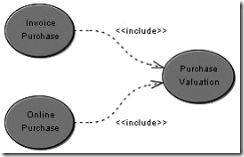
7.3.5 Generalization
When a use case describes a variation on another use case, use a generalization link. In the example below, the use case limit exceeded describes a situation in which the usual scenario of online purchase is not performed. Use cases that generalize another use case should only specify an alternative, even exceptional, scenario to the use case being generalized. The overall goal of the use cases should be the same.
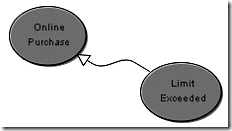
7.3.6 Extends
In some instances you want to describe a variation on behavior in a more controlled form. In such instances you can define extension points in the extended use case. In the example below, search by name is said to extend search at the name extension point. The extends link is more controlled than the generalization link in that functionality can only be added at the extension points.
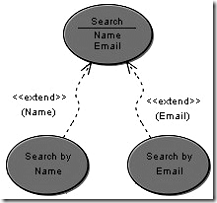
7.3.7 Applications of Use Case Diagrams
Use case diagrams are helpful in three areas.
· Determining features (requirements): New use cases often generate new requirements as the system is analyzed and the design takes shape.
· Communicating with clients: Their notational simplicity makes use case diagrams a good way for developers to communicate with clients.
· Generating test cases: The collection of scenarios for a use case may suggest a suite of test cases for those scenarios.
Self Assessment Questions
1. What do you mean by a use case?
2. What is the purpose of associations in a use case diagram?
7.4 Class Diagrams
The class diagram is core to object-oriented design. It describes the types of objects in the system and the static relationships between them.
7.4.1 Packages
Packages allow you to break up a large number of objects into related groupings. In many object oriented languages (such as Java), packages are used to provide scope and division to classes and interfaces. In the UML, packages serve a similar, but broader purpose.
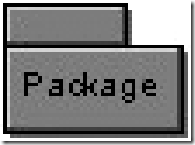
7.4.2 Classes
The core element of the class diagram is the class. In an object oriented system, classes are used to represent entities within the system; entities that often relate to real world objects.
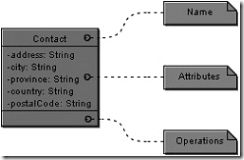
The Contact class above is an example of a simple class that stores location information.
Classes are divided into three sections:
· Top: The name, package and stereotype are shown in the upper section of the class. In Visual Case, classes shown on a diagram that do not belong to the same package as the diagram are shown with their entire path name. You can optionally assign a stereotype to a class.
· Centre: The centre section contains the attributes of the class.
· Bottom: In the lower section are the operations that can be performed on the class.
7.4.3 Attributes
An attribute is a property of a class. In the example above, we are told that a Contact has an address, a city, a province, a country and a postal code. It is generally understood that when implementing the class, functionality is provided to set and retrieve the information stored in attributes. Methods to set and retrieve attribute data are often called accessor methods (also getting and setting methods) and need not be shown in your model as they are usually inferred.
The format for attributes is:
visibility name: type = defaultValue
The visibility is as follows:
In
object oriented design, it is generally preferred to keep most
attributes private as the accessor methods allow you to control access
to the data. The most common exception to this preference is constants.
In addition to the name, visibility, datatype and default value, you can specify the following properties for an attribute:
· Array: you can set an attribute to be treated as an array of attributes; shown with square braces [ ] beside the name.
· Static: attributes that are static only exist once for all instances of the class. In the example above, if we set city to be static, any time we used the Contact class the city attribute would always have the same value.
· Final: if an attribute is declared final, its value cannot be changed. The attribute is a constant.
7.4.4 Operations
The operations listed in a class represent the functions or tasks that can be performed on the data in the class.

In the List class above, there is one attribute (a private array of Objects) and three operations.
The format for operations is:
visibility name (parameters): type
The format is very similar to that of the attribute except with the removal of a default value and the addition of parameters.
Parameters take the format:
direction name: type = default value
The direction can be one of in, out, inout or it can be unspecified.
7.4.5 Generalization
The generalization link is used between two classes to show that a class incorporates all of the attributes and operations of another, but adds to them in some way.
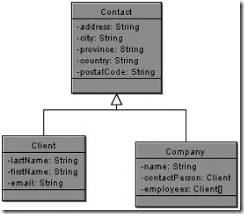
In the above diagram, we again see our Contact class, only now with two child classes. We can say that Client and Company inherit, generalize or extend Contact. In each of Client and Company all of the attributes in Contact (address, city, etc.) exist, but with more information added. In the above situation Contact is said to be the superclass of Client and Company.
When using a generalization link, the child classes have the option to override the operations in the parent class. That is, they can include an operation that is defined in the superclass, but define a new implementation for it.

Above, OntarioTaxCalculator redefines or overrides the implementation of the method in BasicTaxCalculator. Essentially, the code is different but the operation is called the same way.
Sometimes you may want to force children to override methods in a parent class. In this case you can define the methods in the superclass as abstract. If a class has abstract operations, the class itself is considered abstract. Abstract methods and classes are shown in italics. Not all of the operations in an abstract class have to be abstract.
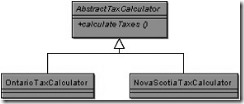
The abstract operation calculateTaxes in AbstractTaxCalculator must be implemented in the child classes OntarioTaxCalculator and NovaScotiaTaxCalculator. Since the operations must be implemented, it is not necessary to show them in the child classes; however you may if you choose. The key is to keep your diagrams as clear as possible. In the above instance the diagram is simple and the meaning clear, however with multiple levels of inheritance and more attributes and operations, you may wish to specify all of the methods that are overridden.
7.4.6 Interfaces
Many object oriented programming languages do not allow for multiple inheritance. The interface is used to solve the limitations posed by this. For example, in the earlier class diagram Client and Company both generalize Contact but one or the other child classes may have something in common with a third class that we do not want to duplicate in multiple classes.

The interface Sortable is used in the above example to show that both Company and Product implement the sort operation. We can say that Company and Product implement Sortable or that they are Sortable. Because Product already generalizes Contact, we could not also allow it to generalize Sortable. Instead, we made Sortable an interface and added a realization link to show the implementation.
Interfaces are very similar to abstract classes with the exception that they do not have any attributes. As well, unlike a class, all of the operations in an interface have no implementation. The child classes Company and Product are forced to implement the sort operation in its entirety.
7.4.7 Associations
Classes can also contain references to each other. The Company class has two attributes that reference the Client class.

Although this is perfectly correct, it is sometimes more expressive to show the attributes as associations.

The above two associations have the same meaning as the attributes in the old version of the Contact class.
The first association (the top one) represents the old contactPerson attribute. There is one contact person in a single Company. The multiplicity of the association is one to one meaning that for every Companythere is one and only one contactPerson and for each contactPerson there is one Company. In the bottom association there are zero or many employees for each company. Multiplicities can be anything you specify. Some examples are shown:
The arrows at the end of the associations represent their navigability. In the above examples, the Company references Clients, but the Client class does not have any knowledge of the Company.
You can set the navigability on either, neither or both ends of your
associations. If there is no navigability shown then the navigability
is unspecified.
7.4.8 Aggregation and Composition

The above example shows an aggregation association and a composition association.
The composition association is represented by the solid diamond. It is said that ProductGroup is composed of Products. This means that if a ProductGroup is destroyed, the Products within the group are destroyed as well.
The aggregation association is represented by the hollow diamond. PurchaseOrder is an aggregate of Products. If a PurchaseOrder is destroyed, the Products still exist.
If you have trouble remembering the difference between composition and aggregation, just think of the alphabet. Composition means destroy and the letters 'c' and 'd' are next to each other.
7.4.9 Dependencies
A dependency exists between two elements if changes to one will affect the other. If for example, a class calls an operation in another class, then a dependency exists between the two. If you change the operation, then the dependent class will have to change as well. When designing your system, the goal is to minimize dependencies.

To help clarify the dependencies in your design, you may wish to draw a Package Diagram. A package diagram is essentially a class diagram with only packages and dependencies showing. Dependencies can exist between any components in the UML however at the highest level, dependencies will exist between packages. Within a package, the dependencies may be too numerous to specify. That is not to say that numerous dependencies are okay. Even within a package you want to limit the dependencies, however between packages in particular you should be strict about the number of dependencies that exist. In general, the fewer the dependencies the more scaleable and maintainable your system will be.
Self Assessment Questions
1. What are attributes? Mention the attributes that may be specified for a class.
2. Outline the difference between aggregation and composition.
7.5 Object Diagrams
Object diagrams show instances instead of classes. They are useful for explaining small pieces with complicated relationships, especially recursive relationships.
This small class diagram shows that a university Department can contain lots of other Departments.

The object diagram below instantiates the class diagram, replacing it by a concrete example.
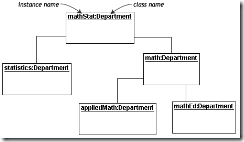
Each rectangle in the object diagram corresponds to a single instance. Instance names are underlined in UML diagrams. Class or instance names may be omitted from object diagrams as long as the diagram meaning is still clear.
7.6 Interaction Diagrams
Once the use cases are specified, and some of the core objects in the system are prototyped on class diagrams, we can start designing the dynamic behavior of the system.
Recall from the Use Case Diagrams sections, that a use case encompasses an interaction between a user and a system. Typically, an interaction diagram captures the behavior of a single case by showing the collaboration of the objects in the system to accomplish the task. These diagrams show objects in the system and the messages that are passed between them.

Let's start with the simple example above: a user logging onto the system. The Logon use case can be specified by the following step:
1. Logon dialog is shown
2. User enters user name and password
3. User clicks on OK or presses the enter key
4. The user name and password are checked and approved
5. The user is allowed into the system
Alternative: Logon Failed - if at step 4 the user name and password are not approved, allow the user to try again
Now that we have a simple Use Case to work with, we can specify some of the classes involved in the interaction.

The LogonDialog has public methods to show and hide the window, and a private method that is called when the user presses the ok button or clicks enter. For our example (and indeed most cases) you need not specify the interface elements of the dialog.
Our design also includes a LogonManager class that will include one method that returns true if the logon is successful, false if it is not.

A DatabaseAccess class will allow us to run queries against our database. We can pass a query string and a ResultSet of data will be returned.

Now that we have prototyped the classes involved in our interaction, we can begin to make our interaction diagrams.
7.6.1 Instances and Messages
Interaction diagrams are composed mainly of instances and messages. An instance is said to be the realization of a class that is if we have a class Doctor, than the instances are Dr. Jones, Dr. Smith, etc. In an object oriented application, instances are what exist when you instantiate a class (create a new variable with the class as its datatype).
In the UML, instances are represented as rectangles with a single label formatted as:
instanceName: datatype
You can choose to name the instance or not, but the datatype should always be specified. Below the name, you can also list the attributes and their values. In Visual Case, you can map attributes from your class and enter new values specific to that instance. Attributes need only be shown when they are important and you don't have to specify and show all of the attributes of a class.
Messages represent operation calls. That is, if an instance calls an operation in itself or another class, a message is passed. Also, upon the completion of the operation a return message is sent back to the instance that initiated the call.
The format for message labels is:
Sequence Iteration [Guard] : name (parameters)
Sequence represents the order in which the message is called. The sequence is redundant on sequence diagrams, but required on collaboration diagrams
Iteration – an asterix (*) is shown to represent iteration if the message is called repeatedly.
Guard – an optional boolean expression (the result is either true or false) that determines if the message is called.
Name represents the operation being called.
Parameters represent the parameters on the operation being called.
7.6.2 Sequence Diagram
Sequence diagrams emphasize the order in which things happen, while collaboration diagrams give more flexibility in their layout. You can use whichever you prefer when drawing interactions, as both show the same information.
An example sequence diagram for our logon collaboration is shown:

Things to Note:
· The flow of time is shown from top to bottom, that is messages higher on the diagram happen before those lower down
· The blue boxes are instances of the represented classes, and the vertical bars below are timelines
· The arrows (links) are messages - operation calls and returns from operations
· The hide and show messages use guards to determine which to call. Guards are always shown in square braces [ ] and represent constraints on the message (the message is sent only if the constraint is satisfied)
· The messages are labeled with the operation being called and parameters are shown. You can choose to enter the parameters or not - this is dependent upon their importance to the collaboration being shown
· The sequence numbers are not shown on the messages as the sequence is intrinsic to the diagram
Asynchronous Messages
You can specify a message as asynchronous if processing can continue while the message is being executed. In the example below, the asynchronous call does not block processing for the regular call right below. This is useful if the operation being called is run remotely, or in another thread.
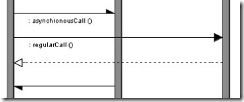
7.6.3 Collaboration Diagram
Collaborations are more complex to follow than sequence diagrams, but they do provide the added benefit of more flexibility in terms of spatial layout.
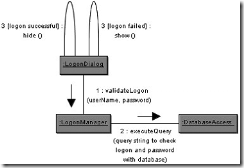
Above is our logon interaction shown as a collaboration diagram. Notice that each message is numbered in sequence, because it is not obvious from the diagram, the order of the messages.
Lollipop Interfaces
Another advantage over the sequence diagram is that collaboration diagrams allow you to show lollipop interfaces.

Suppose that our DatabaseAccess class implemented an interface called Queryable. If the logon manager only has access to the interface, we can show that the message is called through the interface by including a lollipop interface on the diagram. The stick of the lollipop indicates that the class DatabaseAccess realizes Queryable.
Self Assessment Questions
1. What are instances and messages?
2. What are the advantages that a collaboration diagram provides over sequence diagrams?
7.7 Activity and State Diagrams
Previously we saw how interaction diagrams demonstrate the behavior of several objects when executing a single use case. When you wish to show the sequence of events on a broader scale, use activity and state diagrams.
7.7.1 Activity Diagram
An activity is the execution of a task whether it be a physical activity or the execution of code. Simply put, the activity diagram shows the sequence of activities. Like the simple flow chart, activity diagrams have support for conditional behavior, but have added support for parallel execution as well.

Start – each activity diagram has one start (above) at which the sequence of actions begins.

End – each activity diagram has one finish at which the sequence of actions ends.

Activity – activities are connected together by transitions.
Transitions are directed arrows flowing from the previous activity to the next activity. They are optionally accompanied by a textual label of the form:
[guard] label
The guard is a conditional expression that when true indicates that the transition is taken. The label is also optional and is freeform.
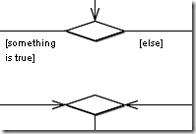
To show conditional behavior, use a branch and a merge. As shown above, the top diamond is a branch and has only one transition flowing into it and any number of mutually exclusive transitions flowing out. That is, the guards on the outgoing transitions must resolve themselves so that only one is followed. The merge is used to end the conditional behavior. There can be any number of incoming, and only one outgoing transition.
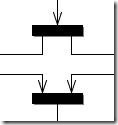
To show parallel behavior, use a fork and a join, as shown above. The fork (top) has one transition entering and any number of transitions exiting, all of which will be taken. The join (bottom) represents the end of the parallel behavior and has any number of transitions entering, and only one leaving.
Activity diagrams can be divided into object swimlanes that determine which object is responsible for which activity.
For our example, we used the following process: "Withdraw money from a bank account through an ATM." The three involved classes (people, etc.) of the activity are Customer, ATM, and Bank. The process begins at the black start circle at the top and ends at the concentric white/black stop circles at the bottom. The activities are rounded rectangles.
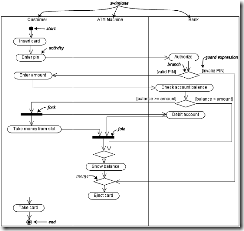
7.7.2 State Diagram
The state diagram shows the change of an object through time. Based upon events that occur, the state diagram shows how the object changes from start to finish.

States are represented as a rounded rectangle with the name of the state shown. Optionally you can include an activity that represents a longer running task during that state.
Connecting states together are transitions. These represent the events that cause the object to change from one state to another. The guard clause of the label is again mutually exclusive and must resolve itself to be either true or false. Actions represent tasks that run causing the transitions.
Actions are different from activities in that actions cannot be interrupted, while an activity can be interrupted by an incoming event. Both ultimately represent an operation on the object being studied. For example, an operation that sets an attribute would be considered an action, while a long calculation might be an activity. The specific separation between the two depends on the object and the system being studied.
Like activity diagrams, state diagrams have one start and one end from at which the state transitions start and end respectively.
Our example diagram models the login part of an online banking system. Logging in consists of entering a valid social security number and personal id number, then submitting the information for validation. Logging in can be factored into four non-overlapping states: Getting SSN, Getting PIN, Validating, and Rejecting. From each state comes a complete set of transitions that determine the subsequent state.
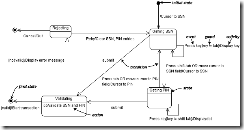
The action that occurs as a result of an event or condition is expressed in the form /action. While in its Validating state, the object does not wait for an outside event to trigger a transition. Instead, it performs an activity. The result of that activity determines its subsequent state.
Self Assessment Questions
1. When is it considered appropriate to use state or activity diagrams?
2. How do you show parallel behavior in an activity diagram?
7.8 Implementation Diagrams – Component and Deployment
So far, we've seen how to diagram the tasks that your system will perform the details of the classes in your system, and the dynamic behavior of the system – but what about the big picture? The two types of implementation diagrams provide the solution. With the deployment diagram, you can show how the components of your system are physically related, and with the component diagram, you can show the components in the system are organized.
A component is a code module. Component diagrams are physical analogs of class diagram. Deployment diagrams show the physical configurations of software and hardware.
You can combine the two diagrams if you choose:
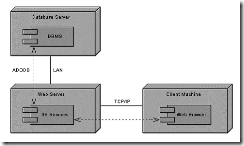
Above, the nodes are shown as cuboids and the components are figures shown within these cuboid-shaped figures. The nodes represent something upon which a component can run, and components are units of software.
On the diagram, nodes are connected with connections that show the physical path of information in the system. Components are connected with directed dashed lines that represent the communication between components. You can also use lollipop interfaces on components to show that communication is through an interface.
7.9 Extensibility Mechanisms
The extensibility mechanisms allow you to customize and extend the UML by adding new building blocks, creating new properties, and specifying new semantics in order to make the language suitable for your specific problem domain. There are three common extensibility mechanisms that are defined by the UML: stereotypes, tagged values, and constraints.
7.9.1 Stereotypes
Stereotypes allow you to extend the vocabulary of the UML so that you can create new model elements, derived from existing ones, but that have specific properties that are suitable for your problem domain. They are used for classifying or marking the UML building blocks in order to introduce new building blocks that speak the language of your domain and that look like primitive, or basic, model elements.
For example, when modeling a network you might need to have symbols for representing routers and hubs. By using stereotyped nodes you can make these things appear as primitive building blocks.
As another example, let us consider exception classes in Java or C++, which you might sometimes have to model. Ideally you would only want to allow them to be thrown and caught, nothing else. Now, by marking them with a suitable stereotype you can make these classes into first class citizens in your model; in other words, you make them appear as basic building blocks.
Stereotypes also allow you to introduce new graphical symbols for providing visual cues to the models that speak the vocabulary of your specific domain, as shown below.

Graphically, a stereotype is rendered as a name enclosed by guillemots and placed above the name of another element.

Alternatively, you can render the stereotyped element by using a new icon associated with that stereotype.

7.9.2 Tagged Values
Tagged values are properties for specifying keyword-value pairs of model elements, where the keywords are attributes. They allow you to extend the properties of a UML building block so that you create new information in the specification of that element. Tagged values can be defined for existing model elements, or for individual stereotypes, so that everything with that stereotype has that tagged value. It is important to mention that a tagged value is not equal to a class attribute. Instead, you can regard a tagged value as being a metadata, since its value applies to the element itself and not to its instances.
One of the most common uses of a tagged value is to specify properties that are relevant to code generation or configuration management. So, for example, you can make use of a tagged value in order to specify the programming language to which you map a particular class, or you can use it to denote the author and the version of a component.
As another example of where tagged values can be useful, consider the release team of a project, which is responsible for assembling, testing, and deploying releases. In such a case it might be feasible to keep track of the version number and test results for each main subsystem, and so one way of adding this information to the models is to use tagged values.
Graphically, a tagged value is rendered as a string enclosed by brackets, which is placed below the name of another model element. The string consists of a name (the tag), a separator (the symbol =), and a value (of the tag), as shown below.

7.9.3 Constraints
Constraints are properties for specifying semantics and/or conditions that must be held true at all times for the elements of a model. They allow you to extend the semantics of a UML building block by adding new rules, or modifying existing ones.
For example, when modeling hard real time systems it could be useful to adorn the models with some additional information, such as time budgets and deadlines. By making use of constraints these timing requirements can easily be captured.
Graphically, a constraint is rendered as a string enclosed by brackets, which is placed near the associated element(s), or connected to the element(s) by dependency relationships. This notation can also be used to adorn a model element’s basic notation, in order to visualize parts of an element’s specification that have no graphical cue.
For example, you can use constraint notation to provide some properties of associations, such as order and changeability. Refer to the diagram below to understand the use of constraints.
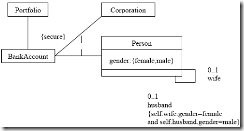
Self Assessment Questions
1. What is the purpose of extensibility mechanisms in UML?
2. Describe the ways in which a stereotype may be rendered.
7.10 Summary
When starting a use case model, it is very important to keep it simple. Often it is easiest to first determine the actors of the system, and then flush out the use cases that they perform. Your use case diagrams can be as simple or complex as you wish, however simpler, less cluttered diagrams are easier to understand, and are often more powerful in capturing the tasks of the system. Remember that a use case represents a goal of a user, not an atomic programming operation. Your use case design should be simple and help to clarify the user's goals and expectations for the system.
Class diagrams really are the core of most object oriented design so you will likely find yourself using them all the time. Fortunately class diagrams closely relate to the most object oriented languages, so the basics (classes, operations, attributes, generalizations, etc.) should be fairly easy to grasp. Start with what you know and then move on.
Keeping your designs simple will allow you to be more productive as well as making your designs far more understandable and useable. Also, as the system is implemented and upgraded, you'll want to keep your design in synch with your implementation. This will be far easier with a simple design of the key concepts of the system.
Using interaction diagrams, we can clarify the sequence of operation calls among objects used to complete a single use case. When drawing these diagrams, try to keep them as clear and simple as possible. Sequence diagrams are easy to read and follow, as they enforce a standard layout on the diagram. Collaborations have the added advantage of interfaces and freedom of layout, but can be difficult to follow, understand and create. It's also important not to confuse interaction diagrams with state and activity diagrams. Interaction diagrams are used to diagram a single use case. When you want to examine the behavior of a single instance over time use a state diagram, and if you want to look at the behavior of the system over time use an activity diagram.
Activity diagrams are used to show workflow in parallel and conditionally. They are useful when working out the order and concurrency of a sequential algorithm, when analyzing the steps in a business process and when working with threads. State diagrams show the change of an object over time and are useful when an object exhibits interesting or unusual behavior - such as that of a user interface component. As always, use these diagrams only when they serve a purpose. Don't feel that you have to draw a state diagram for every object in your system and an activity diagram for every process. Use them where they add to your design. You may not even include these diagrams in your design, and your work may still be complete and useful.
The physical diagrams will help with the overall structure and distribution of your system. You can draw component and deployment diagrams separately or combine them as you choose. Also, you need not show the components within the nodes as above, although it helps in the overall understanding of what is executed where.
Modeling is all about communication. When using the UML you are provided with all the tools you need in order to specify, visualize, construct, and document the elements of a software-intensive system. However, there will be circumstances where you might want to color outside the lines, i.e. bend or extend the modeling language in order to shape and grow it to the specific needs of your project.
Don't get bogged down with semantics and detail. The UML is a very rich and detailed language; remember that you don't have to master every iota of information at first. Get comfortable with the basics first. Similarly, keep your diagrams simple. Each diagram should have one key concept or design feature that you're trying to explain. Further, that key concept or feature should be interesting. You don't need to design the obvious, and you don't need to be redundant. Express what needs to be expressed and move on.
7.11 Terminal Questions
1. Why is UML important?
2. Name the modeling diagrams available in UML.
3. What are the components that may be seen in a use case diagram?
4. Describe generalization with respect to a use case diagram.
5. What are the applications of use case diagrams?
6. What is a package?
7. Name the components of a class.
8. Many object oriented programming languages do not allow multiple inheritance. How can this situation be countered?
9. Describe package diagrams.
10. How are object diagrams different from class diagrams?
11. Name the types of interaction diagrams and describe them.
12. Describe the modeling components found in an activity diagram.
13. Draw a state diagram to show gear transmission in a car.
14. Compare component and deployment diagrams.
15. Describe the extensibility mechanisms of UML.
References and Further Reading
1. http://www.visualcase.com/tutorials/uml-tutorial.htm
2. http://dn.codegear.com/article/31863
3. http://www.cs.ucl.ac.uk/staff/ucacwxe/lectures/3C05-02-03/aswe
15-essay.pdf
Structure
7.1 Introduction
7.2 What is UML?
7.3 Use Case Diagrams
7.3.1 Use Case
7.3.2 Actor
7.3.3 Associations
7.3.4 Includes
7.3.5 Generalization
7.3.6 Extends
7.3.7 Applications of Use Case Diagrams
Self Assessment Questions
7.4 Class Diagrams
7.4.1 Packages
7.4.2 Classes
7.4.3 Attributes
7.4.4 Operations
7.4.5 Generalization
7.4.6 Interfaces
7.4.7 Associations
7.4.8 Aggregation and Composition
7.4.9 Dependencies
Self Assessment Questions
7.5 Object Diagrams
7.6 Interaction Diagrams
7.6.1 Instances and Messages
7.6.2 Sequence Diagram
7.6.3 Collaboration Diagram
Self Assessment Questions
7.7 Activity and State Diagrams
7.7.1 Activity Diagram
7.7.2 State Diagram
Self Assessment Questions
7.8 Implementation Diagrams – Component and Deployment
7.9 Extensibility Mechanisms
7.9.1 Stereotypes
7.9.2 Tagged Values
7.9.3 Constraints
Self Assessment Questions
7.10 Summary
7.11 Terminal Questions
References and Further Reading
7.1 Introduction
Despite the fact that several advanced languages have come out of the Information Age Revolution, such as Java, C++, XML, etc., many people are still designing their code with minimal design in mind. They fall back on the IDE to do the work for them and this as far as the design goes. This may seem acceptable in the short term, but if it’s a long term, large project involving many individuals on the project, this is a recipe for disaster. Although, graphic design has been accepted in many of the other engineering fields: Mechanical, Electrical, Architectural, for some reason software design has been very slow to adopting these methods. The main reason is that most people feel it’s a lot of extra work. Some other reasons are that people feel the tools aren’t quite there yet, lack of understanding of the methodologies, too many competing methods, too much design concepts to learn. UML is an attempt to solve some of the common issues. It’s been marketed well by Rational and it is becoming widely accepted in corporations. It seems to bring together some of the best concepts in the Object-Oriented community and provide a common way for people to communicate design. It is also adopted by the Object Management Group and is quickly becoming a standard. UML is not specific to any one implementation and brings together models that have been used for years by programmers to describe their software. UML may not be perfect design methodology, but it has adapted well to the existing technologies and is what’s out there now.
Objectives
Understanding the contents of this chapter will help you to:
· Understand UML and its advantages.
· Understand Object-Oriented Analysis and Design using UML.
· Describe the various modeling diagrams of UML, i.e., their components, usage considerations, features, and advantages.
· Know the UML extensibility mechanisms.
· Design any kind of project using Object-Oriented Analysis and Design using UML.
7.2 What is UML?
UML is the Unified Modeling Language. The Unified Modeling Language was formed in attempt to unify the best (or most popular in this case) methods in Object-Oriented Analysis and Design. Those concepts come from the leaders in the field of OO: Grady Booch, James Rumbaugh and Ivar Jacobson. The different models are pulled from each of the individual methods and bring in a contribution from each one. For example, the class model is very similar to OMT or the Rumbaugh method. The Use Case Model is brought in from Ivar Jacobson and the implementation model is from Booch. Some models, such as State and Sequence, are a combination of a few methods, taking concepts from each of the methodologies and even adding some new concepts.
The heart of object-oriented problem solving is the construction of a model. The model abstracts the essential details of the underlying problem from its usually complicated real world. Several modeling tools are wrapped under the heading of the UML, which stands for Unified Modeling Language.
Let’s understand the necessity of UML, and how it applies to problem solving. “Why is UML important?” is the inevitable question to be answered. Let's look at this question from the point of view of the construction trade. Architects design buildings. Builders use the designs to create buildings. The more complicated the building, the more critical the communication between architect and builder. Blueprints are the standard graphical language that both architects and builders must learn as part of their trade. Writing software is not unlike constructing a building. The more complicated the underlying system, the more critical the communication among everyone involved in creating and deploying the software. In the past decade, the UML has emerged as the software blueprint language for analysts, designers, and programmers alike. It is now part of the software trade.
The UML gives everyone from business analyst to designer to programmer a common vocabulary to talk about software design. The UML is applicable to object-oriented problem solving. Anyone interested in learning UML must be familiar with the underlying tenet of object-oriented problem solving – it all begins with the construction of a model. A model is an abstraction of the underlying problem. The domain is the actual world from which the problem comes. Models consist of objects that interact by sending each other messages. Think of an object as "alive." Objects have things they know (attributes) and things they can do (behaviors or operations). The values of an object's attributes determine its state. Classes are the "blueprints" for objects. A class wraps attributes (data) and behaviors (methods or functions) into a single distinct entity. Objects are instances of classes.
At the center of the UML are its nine kinds of modeling diagrams, which will be discussed in detail in this unit. The diagrams are:
· Use case diagrams
· Class diagrams
· Object diagrams
· Sequence diagrams
· Collaboration diagrams
· Activity diagrams
· State diagrams
· Component diagrams
· Deployment diagrams
7.3 Use-case Diagrams
In many design processes, the use case diagram is the first that designers will work with when starting a project. This diagram allows for the specification of high level user goals that the system must carry out. These goals are not necessarily tasks or actions, but can be more general required functionality of the system.
7.3.1 Use Case
More formally, a use case is made up of a set of scenarios. Each scenario is a sequence of steps that encompass an interaction between a user and a system. The use case brings scenarios together that accomplish a specific goal of the user.
A use case can be specified by textually describing the steps required and any alternative actions at each step. For example, the use case for searching a web for a keyword might be shown as:
1. Customer enters the keyword
2. Customer clicks the search button
3. The search is executed
4. The results are shown
Alternative: Search Failed
If the search fails at 3, then the user is redirected back to the search screen at step 1
7.3.2 Actor
The use case diagram allows a designer to graphically show these use cases and the actors that use them. An actor is a role that a user plays in the system. It is important to distinguish between a user and an actor (better thought of as a role). A user of the system may play several different roles through the course of his, her or its job (since an actor may be another system). Examples of actors are salesperson, manager, support person, and web store system. It is possible that the same person may be a sales person and also provide support. When creating a use case model, we are not concerned with the individuals, only the roles that they play.
7.3.3 Associations
On a use case diagram, associations are drawn between actors and use cases to show that an actor carries out a use case. A use case can be carried out by many actors and an actor may carry out many use cases.

In the above diagram, the actors are shown as the stick figure shapes on the left, the use cases are the ellipses, and the associations between them are represented by the connecting lines. The developer and the stakeholder both are responsible for specifying the system roles, but only the developer creates the model.
7.3.4 Includes
Use cases can also be related to each other with three different links. The diagram below shows the use of the includes link. Both invoice purchase and online purchase include the scenarios defined by purchase valuation. In general, the includes link is to avoid repetition of scenarios in multiple use cases.

7.3.5 Generalization
When a use case describes a variation on another use case, use a generalization link. In the example below, the use case limit exceeded describes a situation in which the usual scenario of online purchase is not performed. Use cases that generalize another use case should only specify an alternative, even exceptional, scenario to the use case being generalized. The overall goal of the use cases should be the same.

7.3.6 Extends
In some instances you want to describe a variation on behavior in a more controlled form. In such instances you can define extension points in the extended use case. In the example below, search by name is said to extend search at the name extension point. The extends link is more controlled than the generalization link in that functionality can only be added at the extension points.

7.3.7 Applications of Use Case Diagrams
Use case diagrams are helpful in three areas.
· Determining features (requirements): New use cases often generate new requirements as the system is analyzed and the design takes shape.
· Communicating with clients: Their notational simplicity makes use case diagrams a good way for developers to communicate with clients.
· Generating test cases: The collection of scenarios for a use case may suggest a suite of test cases for those scenarios.
Self Assessment Questions
1. What do you mean by a use case?
2. What is the purpose of associations in a use case diagram?
7.4 Class Diagrams
The class diagram is core to object-oriented design. It describes the types of objects in the system and the static relationships between them.
7.4.1 Packages
Packages allow you to break up a large number of objects into related groupings. In many object oriented languages (such as Java), packages are used to provide scope and division to classes and interfaces. In the UML, packages serve a similar, but broader purpose.

7.4.2 Classes
The core element of the class diagram is the class. In an object oriented system, classes are used to represent entities within the system; entities that often relate to real world objects.

The Contact class above is an example of a simple class that stores location information.
Classes are divided into three sections:
· Top: The name, package and stereotype are shown in the upper section of the class. In Visual Case, classes shown on a diagram that do not belong to the same package as the diagram are shown with their entire path name. You can optionally assign a stereotype to a class.
· Centre: The centre section contains the attributes of the class.
· Bottom: In the lower section are the operations that can be performed on the class.
7.4.3 Attributes
An attribute is a property of a class. In the example above, we are told that a Contact has an address, a city, a province, a country and a postal code. It is generally understood that when implementing the class, functionality is provided to set and retrieve the information stored in attributes. Methods to set and retrieve attribute data are often called accessor methods (also getting and setting methods) and need not be shown in your model as they are usually inferred.
The format for attributes is:
visibility name: type = defaultValue
The visibility is as follows:
| - | Private |
| + | Public |
| # | Protected |
| ~ | Package |
In addition to the name, visibility, datatype and default value, you can specify the following properties for an attribute:
· Array: you can set an attribute to be treated as an array of attributes; shown with square braces [ ] beside the name.
· Static: attributes that are static only exist once for all instances of the class. In the example above, if we set city to be static, any time we used the Contact class the city attribute would always have the same value.
· Final: if an attribute is declared final, its value cannot be changed. The attribute is a constant.
7.4.4 Operations
The operations listed in a class represent the functions or tasks that can be performed on the data in the class.

In the List class above, there is one attribute (a private array of Objects) and three operations.
The format for operations is:
visibility name (parameters): type
The format is very similar to that of the attribute except with the removal of a default value and the addition of parameters.
Parameters take the format:
direction name: type = default value
The direction can be one of in, out, inout or it can be unspecified.
7.4.5 Generalization
The generalization link is used between two classes to show that a class incorporates all of the attributes and operations of another, but adds to them in some way.

In the above diagram, we again see our Contact class, only now with two child classes. We can say that Client and Company inherit, generalize or extend Contact. In each of Client and Company all of the attributes in Contact (address, city, etc.) exist, but with more information added. In the above situation Contact is said to be the superclass of Client and Company.
When using a generalization link, the child classes have the option to override the operations in the parent class. That is, they can include an operation that is defined in the superclass, but define a new implementation for it.

Above, OntarioTaxCalculator redefines or overrides the implementation of the method in BasicTaxCalculator. Essentially, the code is different but the operation is called the same way.
Sometimes you may want to force children to override methods in a parent class. In this case you can define the methods in the superclass as abstract. If a class has abstract operations, the class itself is considered abstract. Abstract methods and classes are shown in italics. Not all of the operations in an abstract class have to be abstract.

The abstract operation calculateTaxes in AbstractTaxCalculator must be implemented in the child classes OntarioTaxCalculator and NovaScotiaTaxCalculator. Since the operations must be implemented, it is not necessary to show them in the child classes; however you may if you choose. The key is to keep your diagrams as clear as possible. In the above instance the diagram is simple and the meaning clear, however with multiple levels of inheritance and more attributes and operations, you may wish to specify all of the methods that are overridden.
7.4.6 Interfaces
Many object oriented programming languages do not allow for multiple inheritance. The interface is used to solve the limitations posed by this. For example, in the earlier class diagram Client and Company both generalize Contact but one or the other child classes may have something in common with a third class that we do not want to duplicate in multiple classes.

The interface Sortable is used in the above example to show that both Company and Product implement the sort operation. We can say that Company and Product implement Sortable or that they are Sortable. Because Product already generalizes Contact, we could not also allow it to generalize Sortable. Instead, we made Sortable an interface and added a realization link to show the implementation.
Interfaces are very similar to abstract classes with the exception that they do not have any attributes. As well, unlike a class, all of the operations in an interface have no implementation. The child classes Company and Product are forced to implement the sort operation in its entirety.
7.4.7 Associations
Classes can also contain references to each other. The Company class has two attributes that reference the Client class.

Although this is perfectly correct, it is sometimes more expressive to show the attributes as associations.

The above two associations have the same meaning as the attributes in the old version of the Contact class.
The first association (the top one) represents the old contactPerson attribute. There is one contact person in a single Company. The multiplicity of the association is one to one meaning that for every Companythere is one and only one contactPerson and for each contactPerson there is one Company. In the bottom association there are zero or many employees for each company. Multiplicities can be anything you specify. Some examples are shown:
| 0 | Zero |
| 1 | One |
| 1..* | One or many |
| 1..2, 10..* | One, two or ten and above but not three through nine |
7.4.8 Aggregation and Composition

The above example shows an aggregation association and a composition association.
The composition association is represented by the solid diamond. It is said that ProductGroup is composed of Products. This means that if a ProductGroup is destroyed, the Products within the group are destroyed as well.
The aggregation association is represented by the hollow diamond. PurchaseOrder is an aggregate of Products. If a PurchaseOrder is destroyed, the Products still exist.
If you have trouble remembering the difference between composition and aggregation, just think of the alphabet. Composition means destroy and the letters 'c' and 'd' are next to each other.
7.4.9 Dependencies
A dependency exists between two elements if changes to one will affect the other. If for example, a class calls an operation in another class, then a dependency exists between the two. If you change the operation, then the dependent class will have to change as well. When designing your system, the goal is to minimize dependencies.
To help clarify the dependencies in your design, you may wish to draw a Package Diagram. A package diagram is essentially a class diagram with only packages and dependencies showing. Dependencies can exist between any components in the UML however at the highest level, dependencies will exist between packages. Within a package, the dependencies may be too numerous to specify. That is not to say that numerous dependencies are okay. Even within a package you want to limit the dependencies, however between packages in particular you should be strict about the number of dependencies that exist. In general, the fewer the dependencies the more scaleable and maintainable your system will be.
Self Assessment Questions
1. What are attributes? Mention the attributes that may be specified for a class.
2. Outline the difference between aggregation and composition.
7.5 Object Diagrams
Object diagrams show instances instead of classes. They are useful for explaining small pieces with complicated relationships, especially recursive relationships.
This small class diagram shows that a university Department can contain lots of other Departments.

The object diagram below instantiates the class diagram, replacing it by a concrete example.

Each rectangle in the object diagram corresponds to a single instance. Instance names are underlined in UML diagrams. Class or instance names may be omitted from object diagrams as long as the diagram meaning is still clear.
7.6 Interaction Diagrams
Once the use cases are specified, and some of the core objects in the system are prototyped on class diagrams, we can start designing the dynamic behavior of the system.
Recall from the Use Case Diagrams sections, that a use case encompasses an interaction between a user and a system. Typically, an interaction diagram captures the behavior of a single case by showing the collaboration of the objects in the system to accomplish the task. These diagrams show objects in the system and the messages that are passed between them.

Let's start with the simple example above: a user logging onto the system. The Logon use case can be specified by the following step:
1. Logon dialog is shown
2. User enters user name and password
3. User clicks on OK or presses the enter key
4. The user name and password are checked and approved
5. The user is allowed into the system
Alternative: Logon Failed - if at step 4 the user name and password are not approved, allow the user to try again
Now that we have a simple Use Case to work with, we can specify some of the classes involved in the interaction.

The LogonDialog has public methods to show and hide the window, and a private method that is called when the user presses the ok button or clicks enter. For our example (and indeed most cases) you need not specify the interface elements of the dialog.
Our design also includes a LogonManager class that will include one method that returns true if the logon is successful, false if it is not.
A DatabaseAccess class will allow us to run queries against our database. We can pass a query string and a ResultSet of data will be returned.

Now that we have prototyped the classes involved in our interaction, we can begin to make our interaction diagrams.
7.6.1 Instances and Messages
Interaction diagrams are composed mainly of instances and messages. An instance is said to be the realization of a class that is if we have a class Doctor, than the instances are Dr. Jones, Dr. Smith, etc. In an object oriented application, instances are what exist when you instantiate a class (create a new variable with the class as its datatype).
In the UML, instances are represented as rectangles with a single label formatted as:
instanceName: datatype
You can choose to name the instance or not, but the datatype should always be specified. Below the name, you can also list the attributes and their values. In Visual Case, you can map attributes from your class and enter new values specific to that instance. Attributes need only be shown when they are important and you don't have to specify and show all of the attributes of a class.
Messages represent operation calls. That is, if an instance calls an operation in itself or another class, a message is passed. Also, upon the completion of the operation a return message is sent back to the instance that initiated the call.
The format for message labels is:
Sequence Iteration [Guard] : name (parameters)
Sequence represents the order in which the message is called. The sequence is redundant on sequence diagrams, but required on collaboration diagrams
Iteration – an asterix (*) is shown to represent iteration if the message is called repeatedly.
Guard – an optional boolean expression (the result is either true or false) that determines if the message is called.
Name represents the operation being called.
Parameters represent the parameters on the operation being called.
7.6.2 Sequence Diagram
Sequence diagrams emphasize the order in which things happen, while collaboration diagrams give more flexibility in their layout. You can use whichever you prefer when drawing interactions, as both show the same information.
An example sequence diagram for our logon collaboration is shown:

Things to Note:
· The flow of time is shown from top to bottom, that is messages higher on the diagram happen before those lower down
· The blue boxes are instances of the represented classes, and the vertical bars below are timelines
· The arrows (links) are messages - operation calls and returns from operations
· The hide and show messages use guards to determine which to call. Guards are always shown in square braces [ ] and represent constraints on the message (the message is sent only if the constraint is satisfied)
· The messages are labeled with the operation being called and parameters are shown. You can choose to enter the parameters or not - this is dependent upon their importance to the collaboration being shown
· The sequence numbers are not shown on the messages as the sequence is intrinsic to the diagram
Asynchronous Messages
You can specify a message as asynchronous if processing can continue while the message is being executed. In the example below, the asynchronous call does not block processing for the regular call right below. This is useful if the operation being called is run remotely, or in another thread.

7.6.3 Collaboration Diagram
Collaborations are more complex to follow than sequence diagrams, but they do provide the added benefit of more flexibility in terms of spatial layout.

Above is our logon interaction shown as a collaboration diagram. Notice that each message is numbered in sequence, because it is not obvious from the diagram, the order of the messages.
Lollipop Interfaces
Another advantage over the sequence diagram is that collaboration diagrams allow you to show lollipop interfaces.

Suppose that our DatabaseAccess class implemented an interface called Queryable. If the logon manager only has access to the interface, we can show that the message is called through the interface by including a lollipop interface on the diagram. The stick of the lollipop indicates that the class DatabaseAccess realizes Queryable.
Self Assessment Questions
1. What are instances and messages?
2. What are the advantages that a collaboration diagram provides over sequence diagrams?
7.7 Activity and State Diagrams
Previously we saw how interaction diagrams demonstrate the behavior of several objects when executing a single use case. When you wish to show the sequence of events on a broader scale, use activity and state diagrams.
7.7.1 Activity Diagram
An activity is the execution of a task whether it be a physical activity or the execution of code. Simply put, the activity diagram shows the sequence of activities. Like the simple flow chart, activity diagrams have support for conditional behavior, but have added support for parallel execution as well.
Start – each activity diagram has one start (above) at which the sequence of actions begins.
End – each activity diagram has one finish at which the sequence of actions ends.
Activity – activities are connected together by transitions.
Transitions are directed arrows flowing from the previous activity to the next activity. They are optionally accompanied by a textual label of the form:
[guard] label
The guard is a conditional expression that when true indicates that the transition is taken. The label is also optional and is freeform.

To show conditional behavior, use a branch and a merge. As shown above, the top diamond is a branch and has only one transition flowing into it and any number of mutually exclusive transitions flowing out. That is, the guards on the outgoing transitions must resolve themselves so that only one is followed. The merge is used to end the conditional behavior. There can be any number of incoming, and only one outgoing transition.

To show parallel behavior, use a fork and a join, as shown above. The fork (top) has one transition entering and any number of transitions exiting, all of which will be taken. The join (bottom) represents the end of the parallel behavior and has any number of transitions entering, and only one leaving.
Activity diagrams can be divided into object swimlanes that determine which object is responsible for which activity.
For our example, we used the following process: "Withdraw money from a bank account through an ATM." The three involved classes (people, etc.) of the activity are Customer, ATM, and Bank. The process begins at the black start circle at the top and ends at the concentric white/black stop circles at the bottom. The activities are rounded rectangles.

7.7.2 State Diagram
The state diagram shows the change of an object through time. Based upon events that occur, the state diagram shows how the object changes from start to finish.

States are represented as a rounded rectangle with the name of the state shown. Optionally you can include an activity that represents a longer running task during that state.
Connecting states together are transitions. These represent the events that cause the object to change from one state to another. The guard clause of the label is again mutually exclusive and must resolve itself to be either true or false. Actions represent tasks that run causing the transitions.
Actions are different from activities in that actions cannot be interrupted, while an activity can be interrupted by an incoming event. Both ultimately represent an operation on the object being studied. For example, an operation that sets an attribute would be considered an action, while a long calculation might be an activity. The specific separation between the two depends on the object and the system being studied.
Like activity diagrams, state diagrams have one start and one end from at which the state transitions start and end respectively.
Our example diagram models the login part of an online banking system. Logging in consists of entering a valid social security number and personal id number, then submitting the information for validation. Logging in can be factored into four non-overlapping states: Getting SSN, Getting PIN, Validating, and Rejecting. From each state comes a complete set of transitions that determine the subsequent state.

The action that occurs as a result of an event or condition is expressed in the form /action. While in its Validating state, the object does not wait for an outside event to trigger a transition. Instead, it performs an activity. The result of that activity determines its subsequent state.
Self Assessment Questions
1. When is it considered appropriate to use state or activity diagrams?
2. How do you show parallel behavior in an activity diagram?
7.8 Implementation Diagrams – Component and Deployment
So far, we've seen how to diagram the tasks that your system will perform the details of the classes in your system, and the dynamic behavior of the system – but what about the big picture? The two types of implementation diagrams provide the solution. With the deployment diagram, you can show how the components of your system are physically related, and with the component diagram, you can show the components in the system are organized.
A component is a code module. Component diagrams are physical analogs of class diagram. Deployment diagrams show the physical configurations of software and hardware.
You can combine the two diagrams if you choose:

Above, the nodes are shown as cuboids and the components are figures shown within these cuboid-shaped figures. The nodes represent something upon which a component can run, and components are units of software.
On the diagram, nodes are connected with connections that show the physical path of information in the system. Components are connected with directed dashed lines that represent the communication between components. You can also use lollipop interfaces on components to show that communication is through an interface.
7.9 Extensibility Mechanisms
The extensibility mechanisms allow you to customize and extend the UML by adding new building blocks, creating new properties, and specifying new semantics in order to make the language suitable for your specific problem domain. There are three common extensibility mechanisms that are defined by the UML: stereotypes, tagged values, and constraints.
7.9.1 Stereotypes
Stereotypes allow you to extend the vocabulary of the UML so that you can create new model elements, derived from existing ones, but that have specific properties that are suitable for your problem domain. They are used for classifying or marking the UML building blocks in order to introduce new building blocks that speak the language of your domain and that look like primitive, or basic, model elements.
For example, when modeling a network you might need to have symbols for representing routers and hubs. By using stereotyped nodes you can make these things appear as primitive building blocks.
As another example, let us consider exception classes in Java or C++, which you might sometimes have to model. Ideally you would only want to allow them to be thrown and caught, nothing else. Now, by marking them with a suitable stereotype you can make these classes into first class citizens in your model; in other words, you make them appear as basic building blocks.
Stereotypes also allow you to introduce new graphical symbols for providing visual cues to the models that speak the vocabulary of your specific domain, as shown below.

Graphically, a stereotype is rendered as a name enclosed by guillemots and placed above the name of another element.

Alternatively, you can render the stereotyped element by using a new icon associated with that stereotype.

7.9.2 Tagged Values
Tagged values are properties for specifying keyword-value pairs of model elements, where the keywords are attributes. They allow you to extend the properties of a UML building block so that you create new information in the specification of that element. Tagged values can be defined for existing model elements, or for individual stereotypes, so that everything with that stereotype has that tagged value. It is important to mention that a tagged value is not equal to a class attribute. Instead, you can regard a tagged value as being a metadata, since its value applies to the element itself and not to its instances.
One of the most common uses of a tagged value is to specify properties that are relevant to code generation or configuration management. So, for example, you can make use of a tagged value in order to specify the programming language to which you map a particular class, or you can use it to denote the author and the version of a component.
As another example of where tagged values can be useful, consider the release team of a project, which is responsible for assembling, testing, and deploying releases. In such a case it might be feasible to keep track of the version number and test results for each main subsystem, and so one way of adding this information to the models is to use tagged values.
Graphically, a tagged value is rendered as a string enclosed by brackets, which is placed below the name of another model element. The string consists of a name (the tag), a separator (the symbol =), and a value (of the tag), as shown below.

7.9.3 Constraints
Constraints are properties for specifying semantics and/or conditions that must be held true at all times for the elements of a model. They allow you to extend the semantics of a UML building block by adding new rules, or modifying existing ones.
For example, when modeling hard real time systems it could be useful to adorn the models with some additional information, such as time budgets and deadlines. By making use of constraints these timing requirements can easily be captured.
Graphically, a constraint is rendered as a string enclosed by brackets, which is placed near the associated element(s), or connected to the element(s) by dependency relationships. This notation can also be used to adorn a model element’s basic notation, in order to visualize parts of an element’s specification that have no graphical cue.
For example, you can use constraint notation to provide some properties of associations, such as order and changeability. Refer to the diagram below to understand the use of constraints.

Self Assessment Questions
1. What is the purpose of extensibility mechanisms in UML?
2. Describe the ways in which a stereotype may be rendered.
7.10 Summary
When starting a use case model, it is very important to keep it simple. Often it is easiest to first determine the actors of the system, and then flush out the use cases that they perform. Your use case diagrams can be as simple or complex as you wish, however simpler, less cluttered diagrams are easier to understand, and are often more powerful in capturing the tasks of the system. Remember that a use case represents a goal of a user, not an atomic programming operation. Your use case design should be simple and help to clarify the user's goals and expectations for the system.
Class diagrams really are the core of most object oriented design so you will likely find yourself using them all the time. Fortunately class diagrams closely relate to the most object oriented languages, so the basics (classes, operations, attributes, generalizations, etc.) should be fairly easy to grasp. Start with what you know and then move on.
Keeping your designs simple will allow you to be more productive as well as making your designs far more understandable and useable. Also, as the system is implemented and upgraded, you'll want to keep your design in synch with your implementation. This will be far easier with a simple design of the key concepts of the system.
Using interaction diagrams, we can clarify the sequence of operation calls among objects used to complete a single use case. When drawing these diagrams, try to keep them as clear and simple as possible. Sequence diagrams are easy to read and follow, as they enforce a standard layout on the diagram. Collaborations have the added advantage of interfaces and freedom of layout, but can be difficult to follow, understand and create. It's also important not to confuse interaction diagrams with state and activity diagrams. Interaction diagrams are used to diagram a single use case. When you want to examine the behavior of a single instance over time use a state diagram, and if you want to look at the behavior of the system over time use an activity diagram.
Activity diagrams are used to show workflow in parallel and conditionally. They are useful when working out the order and concurrency of a sequential algorithm, when analyzing the steps in a business process and when working with threads. State diagrams show the change of an object over time and are useful when an object exhibits interesting or unusual behavior - such as that of a user interface component. As always, use these diagrams only when they serve a purpose. Don't feel that you have to draw a state diagram for every object in your system and an activity diagram for every process. Use them where they add to your design. You may not even include these diagrams in your design, and your work may still be complete and useful.
The physical diagrams will help with the overall structure and distribution of your system. You can draw component and deployment diagrams separately or combine them as you choose. Also, you need not show the components within the nodes as above, although it helps in the overall understanding of what is executed where.
Modeling is all about communication. When using the UML you are provided with all the tools you need in order to specify, visualize, construct, and document the elements of a software-intensive system. However, there will be circumstances where you might want to color outside the lines, i.e. bend or extend the modeling language in order to shape and grow it to the specific needs of your project.
Don't get bogged down with semantics and detail. The UML is a very rich and detailed language; remember that you don't have to master every iota of information at first. Get comfortable with the basics first. Similarly, keep your diagrams simple. Each diagram should have one key concept or design feature that you're trying to explain. Further, that key concept or feature should be interesting. You don't need to design the obvious, and you don't need to be redundant. Express what needs to be expressed and move on.
7.11 Terminal Questions
1. Why is UML important?
2. Name the modeling diagrams available in UML.
3. What are the components that may be seen in a use case diagram?
4. Describe generalization with respect to a use case diagram.
5. What are the applications of use case diagrams?
6. What is a package?
7. Name the components of a class.
8. Many object oriented programming languages do not allow multiple inheritance. How can this situation be countered?
9. Describe package diagrams.
10. How are object diagrams different from class diagrams?
11. Name the types of interaction diagrams and describe them.
12. Describe the modeling components found in an activity diagram.
13. Draw a state diagram to show gear transmission in a car.
14. Compare component and deployment diagrams.
15. Describe the extensibility mechanisms of UML.
References and Further Reading
1. http://www.visualcase.com/tutorials/uml-tutorial.htm
2. http://dn.codegear.com/article/31863
3. http://www.cs.ucl.ac.uk/staff/ucacwxe/lectures/3C05-02-03/aswe
15-essay.pdf
No comments:
Post a Comment